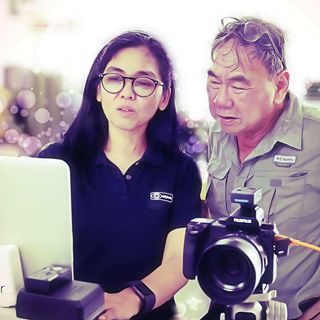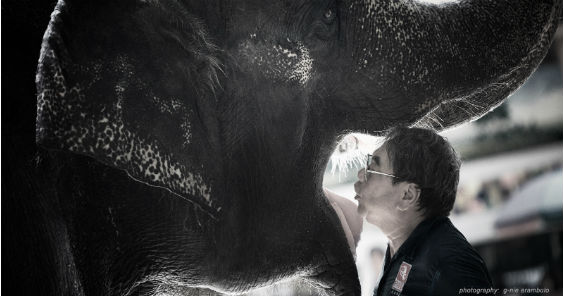By Harry Mosquera
John K. Chua, one of Philippine advertising’s most enduring, and most beloved, photographers, lost his battle to colon cancer last January 7, just a couple of weeks shy of his 70th birthday.
By his own recollection, he started his career as a 23-year-old photo hobbyist who dreamed to be a freelance news photographer. His dream was made challenging with the imposition of Martial Law, and government clamping down on media. He survived by servicing regional media and travel magazines. By the time of the People Power Revolution, he had decided to focus on advertising photography. The result of his efforts was Adphoto, a successful studio that catered to blue-chip accounts.
A true professional, John had a reputation for thoroughness and perfection among advertising agency people and client advertisers. “He was exacting, methodical, detail-oriented, generous with knowledge, and always delivered the goods,” notes Tonette Lee, formerly product marketing head of Nissan Philippines. “I think I will always consider the opportunity to work with John Chua as a gift, a highlight of my career.”

G-nie Arambulo, widely acknowledged as his protégé at Adphoto, considered it an honor and a privilege to work with the man whom she fondly called “Tatay John.” For her, he was a well-disciplined man with a strong value for his work. She remembers well the lessons and insights he shared with her: “He would always say… ‘In everything that you do, do your best, no excuses!’. Every day is a learning experience. ‘Life ends, when you stop learning’. He knew what he wanted and he would get it. He would always remind me to dream saying, ‘Hindi masamang mangarap! Dream big, G-nie, and just do it!’”
In fact, one of the best memories of G-nie was after an aerial shoot in Tarlac where she had an opportunity to ride a R-77 helicopter piloted by a Captain Landrito. “It was the wildest ride of my life,” she says. “We were riding a helicopter but it feels like we were on a roller coaster ride. I’m glad to have experienced it with Tatay John.”
Suzy Roxas, now a practicing psychologist specializing on women’s issues, was a young advertising account executive when she worked with John, and also remembers his hardworking ethic. “He was… respectful of other people’s ideas… working with him meant that you had to be as dedicated as him too.”

John liked to collaborate with both the ad agency and the advertisers, and was generous with sharing his ideas. Yeyey Yatco, who worked as an art director for McCann-Erickson, recalled his first shoot with John for the Hi-C account. “I was a young visualizer then,” Yeyey recalls. “It was a simple product shot but John explained everything to me, knowing that I was new to the industry. It was with him I learned about different film formats, sizes, and uses. He was also very patient in answering my questions.”
In the case of John Chua, patience and impatience were two traits that were also on the same coin. The man could simply not stand still; his innate curiosity and creativity meant that he had to have outlets for his excess energy – hence his numerous interests, which were usually anchored on his love for photography. His personal projects like Flight with an Ultralight took him to the sky – and to different locations throughout the Philippines. His PWD (Photography with a Difference) was an advocacy with established professional photographers to benefit people with disabilities. Partnered with PWD (people with disability) organizations, this helped children with autism to communicate how they looked at the world through the lens of a camera. His famous Bachang Advocacy for Banaue rallied both highlanders and lowlanders alike, from private and government sectors, to restore the Batad Rice Terraces. His love for the Ifugaos made him an adopted son of the community. And who could forget his famous love affair with Maali, the Sri Lankan elephant of Manila Zoo, who reciprocated his caring attention with trust and devotion? Even the U.S.-based group People for the Ethical Treatment of Animals (PETA) had to back down from their efforts to transfer the elephant to a foreign sanctuary in the face of Maali’s dedicated advocate and champion, who got the support and backing of Manila City Hall and Malacanang Palace to keep Maali in Manila Zoo.
For John, nothing seemed impossible if you had the passion for it. Yeyey remembers a brochure shoot he had for the Isuzu Fuego pick-up. “We were in the middle of a stream in Tanay,” he says. “And John parks his van. (He) started pulling, strapping, unfolding, clamping, pushing, and just moving stuff from his van and we had a studio! All of these were D-I-Y designed by John! We had a canopy, tables, and chairs, and even a dining area in the middle of a stream! He had complete lighting equipment and all the necessary things for a shoot. That was John for you. Nothing was impossible for him.”
He also had a heart for the less fortunate. As Tonette shares, she received a call from John in 2014 about a project he had in mind for the Badjao children in Quezon. “Tonette,” he said, “the Badjaos, they beg, but they will never steal. Help me send their kids to school.” So she put John in touch with people who could equip the Badjao school in Quezon so the children could have better lives. “I think more than any commercial or artistic legacy, the way he changed lives is his greatest contribution,” muses Tonette.
Indeed, after he was told by his doctors in August 2017 that they have done that best that they could in treating his cancer, and gave him three to four months to live, John went into overdrive. Even in his remaining months, John continued to affect (and influence) lives for the better. He brainstormed on old projects and new – from the documentation of his substantial archives to hosting the current crop of press photographers to interact with their seniors, offering the hospitality of his own studio.
He transformed his Facebook page into a forum of positivity, making his Facebook friends and followers look forward to his sharing his thoughts on pain, faith, love, and life. “It’s good to be alive… or at least try,” he wrote. Like his passions, his humor could hardly be contained by pain and sickness: “It’s expensive whether to live or die… then you might as well strive to live.”
For G-nie, an indelible legacy of John was his ability to share a part of him in every person he met. “You always hear one great story from a person whose life he touched,” she says.
Meo Remalante, a seasoned art director and fellow photo hobbyist, considers John a tough act to follow, not only for his incredible portfolio of work, but with all of the amazing projects that he was able to undertake across many sectors of society. He cites a quote that he attributes to John, which captures the essence of the man: “Dream big. Nothing is impossible. Shoot from the heart!”







